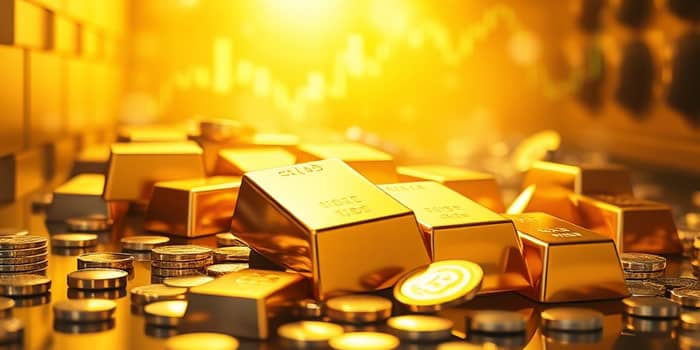For millennia, civilizations have treasured precious metals as symbols of wealth and stability. Today, investing in these tangible assets offers modern investors a way to diversify portfolios and protect wealth against economic turbulence.
From small silver rounds to large gold bars, precious metals remain a compelling choice for those seeking both security and opportunity.
Why Invest in Precious Metals?
In an era of rapidly shifting markets and unpredictable monetary policies, precious metals provide a tangible asset class with intrinsic value that transcends paper currencies. Investors turn to metals for several core reasons:
- Portfolio diversification and risk mitigation
- Inflation hedge when fiat currencies weaken
- Store of value during geopolitical uncertainty
- Speculative opportunities in niche market trends
Investment Methods at a Glance
Precious metals can be acquired and held through various channels, each offering distinct advantages and challenges. Understanding these options is the first step toward a balanced investment strategy.
- Physical Bullion
- Exchange-Traded Funds (ETFs)
- Mining Stocks and Funds
- Futures and Options Contracts
- Metal Certificates
- Royalty and Streaming Companies
- Precious Metals IRAs
Exploring Each Investment Method
Physical bullion includes coins, rounds, bars, and ingots made from gold, silver, platinum, or palladium. Investors who choose tangible metal often seek the reassurance of holding their wealth directly. However, ownership requires modern secure storage solutions—such as home safes, private vaults, or bank safety deposit boxes—and appropriate insurance coverage.
When purchasing physical metal, always verify dealer reputation and authenticity certifications. Premiums over spot price will vary based on metal type, weight, rarity, and collectible features, and physical holdings can present liquidity challenges in fast-moving markets.
Exchange-Traded Funds (ETFs) offer exposure to metal prices without handling physical inventory. These funds trade on major exchanges, allowing investors to buy or sell shares within brokerage accounts. ETFs are known for highly liquid and easy to trade shares with low management fees that have trended downward over time.
While convenient, ETF investors do not receive physical metal and hold no direct claim on underlying assets. This lack of tangibility may concern those preparing for extreme financial crises or personal ownership preferences.
Investing in mining stocks and funds provides leveraged exposure to metal price fluctuations. Individual mining company stocks can amplify returns—sometimes five to ten times the movement in underlying metal prices—while offering potential dividend income and tangible cash flows from mining operations.
Mining ETFs bundle shares of multiple companies, reducing single-stock risk but introducing broader equity market influences. These products suit experienced investors comfortable analyzing corporate fundamentals and sector dynamics.
Futures and options contracts represent advanced derivative vehicles that allow larger bets on metal prices. These instruments offer potential for significant leveraged returns but also carry heightened risk, including the possibility of rapid losses if market directions shift unexpectedly.
Certificates issued by banks or bullion dealers grant legal ownership of a specified amount of metal without physical possession. Certificates eliminate storage hassles but rely on issuer solvency and may have limited value in severe systemic crises.
Royalty and streaming companies finance mining operations in exchange for future production rights. These investments often combine lower risk profiles with upside potential linked to metal discovery and extraction, making them attractive alternatives to direct mining ownership.
Finally, self-directed IRA for tax advantages programs allow precious metals to be held within retirement accounts. These IRAs carry strict requirements regarding approved metals, custodianship, and documentation but offer tax-deferred or tax-free growth under certain conditions.
Market Drivers and Outlook for 2025
Several key factors influence precious metals prices and offer insight into future trends:
Industrial demand, especially for silver, is surging due to green technology. Solar energy applications alone could consume up to 98% of current global silver reserves by mid-century. Meanwhile, vehicle electrification and global infrastructure projects boost demand for platinum and palladium in catalytic converters and hydrogen fuel cells.
Monetary policy remains a critical driver. Central bank interest rate decisions shape opportunity costs for non-yielding assets. With several rate cuts anticipated in 2025, inflation hedges may regain favor, potentially lifting metal prices.
Institutional and central bank purchases also play a major role. Emerging economies continue to diversify reserves with gold and silver, while major institutions explore metal-backed financial instruments to balance equity-heavy portfolios.
Pros and Cons of Precious Metals
Understanding the advantages and drawbacks of precious metals helps investors align choices with goals and risk tolerance.
Advantages include:
- Portfolio diversification beyond traditional asset classes
- Potential inflation hedge and currency protection
- Tangible asset ownership without counterparty risk
- Long-term historical store of value
Disadvantages encompass:
- Storage, insurance, and security costs for physical holdings
- Absence of yield or dividends (except mining equities)
- Price volatility during economic recoveries
- Liquidity constraints for large physical transactions
Getting Started: Tips for Beginners
New investors should begin by defining clear objectives: desired budget, investment horizon, and risk tolerance. Research reputable dealers or brokerage platforms, and compare spot prices with dealer premiums to find fair pricing.
Consider splitting investments between physical and paper products to balance liquidity with ownership preferences. Always account for storage solutions early, whether a secure home safe or professional vault services.
Smaller budgets can start with fractional-size bars or affordable silver rounds, gradually scaling positions over time to average into market fluctuations. Regularly monitor central bank announcements and industrial demand trends to stay informed.
Portfolio Allocation Strategies
Allocating a portion of a diversified portfolio to precious metals can enhance resilience during market downturns. The following table illustrates a sample allocation mix for a balanced investor:
Rebalancing these allocations annually or semi-annually helps maintain target exposures and captures price movements across different metal types. Adjust allocations based on evolving market conditions and individual financial goals.
Conclusion
Investing in precious metals combines tradition and innovation, offering both security and potential growth. By selecting suitable methods—whether holding physical bullion, trading ETFs, or exploring mining equities—investors can craft a strategy that aligns with their financial aspirations.
With careful planning, informed dealer selection, and regular portfolio reviews, precious metals can become a powerful component of a resilient wealth-building plan.
References
- https://www.investopedia.com/articles/basics/09/precious-metals-gold-silver-platinum.asp
- https://www.lynalden.com/precious-metals-investing/
- https://a.co/d/07DOCOx
- https://learn.apmex.com/investing-guide/
- https://money.com/investing-in-precious-metals/
- https://goldsilver.com/industry-news/article/silver-price-forecast-predictions/
- https://www.fidelity.com/learning-center/trading-investing/how-to-buy-gold
- https://sprott.com/investment-strategies/exchange-listed-products/physical-bullion-funds/your-guide-to-owning-physical-precious-metals/










